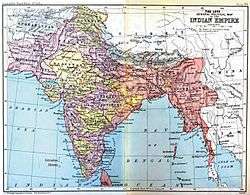History of the British Raj
|
Imperial entities of India | |
| Dutch India | 1605–1825 |
|---|---|
| Danish India | 1620–1869 |
| French India | 1769–1954 |
| Casa da Índia | 1434–1833 |
| Portuguese East India Company | 1628–1633 |
| East India Company | 1612–1757 |
| Company rule in India | 1757–1858 |
| British Raj | 1858–1947 |
| British rule in Burma | 1824–1948 |
| Princely states | 1721–1949 |
| Partition of India |
1947 |
|
| |
The history of the British Raj refers to the period of British rule on the Indian subcontinent between 1858 and 1947. The system of governance was instituted in 1858 when the rule of the East India Company was transferred to the Crown in the person of Queen Victoria (who in 1876 was proclaimed Empress of India). It lasted until 1947, when the British provinces of India were partitioned into two sovereign dominion states: the Dominion of India and the Dominion of Pakistan, leaving the princely states to choose between them. The two new dominions later became the Republic of India and the Islamic Republic of Pakistan (the eastern half of which, still later, became the People's Republic of Bangladesh). The province of Burma in the eastern region of the Indian Empire had been made a separate colony in 1937 and became independent in 1948.
Prelude
Effects on the economy
In the second half of the 19th century, both the direct administration of India by the British crown and the technological change ushered in by the industrial revolution, had the effect of closely intertwining the economies of India and Great Britain.[1] In fact many of the major changes in transport and communications (that are typically associated with Crown Rule of India) had already begun before the Mutiny. Since Dalhousie had embraced the technological change then rampant in Great Britain, India too saw rapid development of all those technologies. Railways, roads, canals, and bridges were rapidly built in India and telegraph links equally rapidly established in order that raw materials, such as cotton, from India's hinterland could be transported more efficiently to ports, such as Bombay, for subsequent export to England.[2] Likewise, finished goods from England were transported back just as efficiently, for sale in the burgeoning Indian markets.[3] However, unlike Britain itself, where the market risks for the infrastructure development were borne by private investors, in India, it was the taxpayers—primarily farmers and farm-labourers—who endured the risks, which, in the end, amounted to £50 million.[4] In spite of these costs, very little skilled employment was created for Indians. By 1920, with the fourth largest railway network in the world and a history of 60 years of its construction, only ten per cent of the "superior posts" in the Indian Railways were held by Indians.[5]
The rush of technology was also changing the agricultural economy in India: by the last decade of the 19th century, a large fraction of some raw materials—not only cotton, but also some food-grains—were being exported to faraway markets.[6] Consequently, many small farmers, dependent on the whims of those markets, lost land, animals, and equipment to money-lenders.[6] More tellingly, the latter half of the 19th century also saw an increase in the number of large-scale famines in India. Although famines were not new to the subcontinent, these were particularly severe, with tens of millions dying,[7] and with many critics, both British and Indian, laying the blame at the doorsteps of the lumbering colonial administrations.[6]
-

The 1909 Map of Indian Railways, when India had the fourth largest railway network in the world. Railway construction in India began in 1853.
-
"The most magnificent railway station in the world." Stereographic image of Victoria Terminus, Bombay, which was completed in 1888.
-
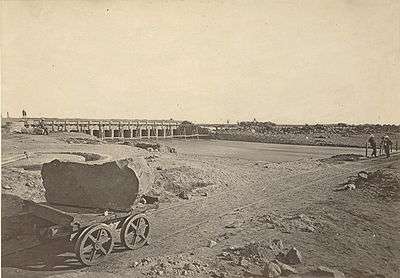
The Agra canal (c. 1873), a year away from completion. The canal was closed to navigation in 1904 in order to increase irrigation and aid in famine-prevention.
-
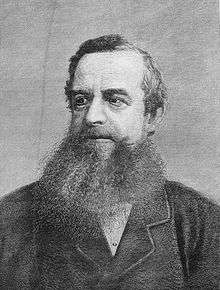
Lord Ripon, the Liberal Viceroy of India, who instituted the Famine Code
Beginnings of self-government
The first steps were taken toward self-government in British India in the late 19th century with the appointment of Indian counsellors to advise the British viceroy and the establishment of provincial councils with Indian members; the British subsequently widened participation in legislative councils with the Indian Councils Act 1892. Municipal Corporations and District Boards were created for local administration; they included elected Indian members.
The Indian Councils Act 1909 — also known as the Morley-Minto Reforms (John Morley was the secretary of state for India, and Gilbert Elliot, fourth earl of Minto, was viceroy) — gave Indians limited roles in the central and provincial legislatures, known as legislative councils. Indians had previously been appointed to legislative councils, but after the reforms some were elected to them. At the centre, the majority of council members continued to be government-appointed officials, and the viceroy was in no way responsible to the legislature. At the provincial level, the elected members, together with unofficial appointees, outnumbered the appointed officials, but responsibility of the governor to the legislature was not contemplated. Morley made it clear in introducing the legislation to the British Parliament that parliamentary self-government was not the goal of the British government.
The Morley-Minto Reforms were a milestone. Step by step, the elective principle was introduced for membership in Indian legislative councils. The "electorate" was limited, however, to a small group of upper-class Indians. These elected members increasingly became an "opposition" to the "official government". The Communal electorates were later extended to other communities and made a political factor of the Indian tendency toward group identification through religion.
-
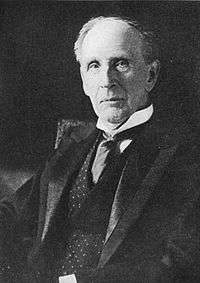
John Morley, the Secretary of State for India from 1905 to 1910, and Gladstonian Liberal. The Indian Councils Act 1909, also known as the Minto-Morley Reforms allowed Indians to be elected to the Legislative Council.
-

Picture post card of the Gordon Highlanders marching past King George V and Queen Mary at the Delhi Durbar on December 12, 1911, when the King was crowned Emperor of India.
-
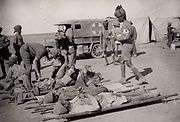
Indian medical orderlies attending to wounded soldiers with the Mesopotamian Expeditionary Force in Mesopotamia during World War I.
World War I and its aftermath
World War I would prove to be a watershed in the imperial relationship between Britain and India. 1.4 million Indian and British soldiers of the British Indian Army would take part in the war and their participation would have a wider cultural fallout: news of Indian soldiers fighting and dying with British soldiers, as well as soldiers from dominions like Canada and Australia, would travel to distant corners of the world both in newsprint and by the new medium of the radio.[8] India’s international profile would thereby rise and would continue to rise during the 1920s.[8] It was to lead, among other things, to India, under its own name, becoming a founding member of the League of Nations in 1920 and participating, under the name, "Les Indes Anglaises" (The British Indies), in the 1920 Summer Olympics in Antwerp.[9] Back in India, especially among the leaders of the Indian National Congress, it would lead to calls for greater self-government for Indians.[8]
In 1916, in the face of new strength demonstrated by the nationalists with the signing of the Lucknow Pact and the founding of the Home Rule leagues, and the realization, after the disaster in the Mesopotamian campaign, that the war would likely last longer, the new Viceroy, Lord Chelmsford, cautioned that the Government of India needed to be more responsive to Indian opinion.[10] Towards the end of the year, after discussions with the government in London, he suggested that the British demonstrate their good faith – in light of the Indian war role – through a number of public actions, including awards of titles and honors to princes, granting of commissions in the army to Indians, and removal of the much-reviled cotton excise duty, but most importantly, an announcement of Britain's future plans for India and an indication of some concrete steps.[10] After more discussion, in August 1917, the new Liberal Secretary of State for India, Edwin Montagu, announced the British aim of "increasing association of Indians in every branch of the administration, and the gradual development of self-governing institutions, with a view to the progressive realization of responsible government in India as an integral part of the British Empire."[10] This envisioned reposing confidence in the educated Indians, so far disdained as an unrepresentative minority, who were described by Montague as "Intellectually our children".[11] The pace of the reforms where to be determined by Britain as and when the Indians were seen to have earned it.[11] However, although the plan envisioned limited self-government at first only in the provinces – with India emphatically within the British Empire – it represented the first British proposal for any form of representative government in a non-white colony.
Earlier, at the onset of World War I, the reassignment of most of the British army in India to Europe and Mesopotamia had led the previous Viceroy, Lord Harding, to worry about the "risks involved in denuding India of troops."[8] Revolutionary violence had already been a concern in British India; consequently in 1915, to strengthen its powers during what it saw was a time of increased vulnerability, the Government of India passed the Defence of India Act, which allowed it to intern politically dangerous dissidents without due process and added to the power it already had – under the 1910 Press Act – both to imprison journalists without trial and to censor the press.[12] Now, as constitutional reform began to be discussed in earnest, the British began to consider how new moderate Indians could be brought into the fold of constitutional politics and simultaneously, how the hand of established constitutionalists could be strengthened.[12] However, since the reform plan was devised during a time when extremist violence had ebbed as a result of increased war-time governmental control and it now feared a revival of revolutionary violence,[11] the government also began to consider how some of its war-time powers could be extended into peace time.[12][12]
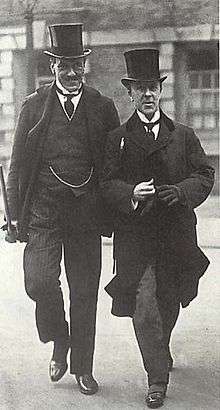
Consequently, in 1917, even as Edwin Montagu announced the new constitutional reforms, a sedition committee chaired by a British judge, Mr. S. A. T. Rowlatt, was tasked with investigating war-time revolutionary conspiracies and the German and Bolshevik links to the violence in India,[13][14][15] with the unstated goal of extending the government's war-time powers.[10] The Rowlatt committee presented its report in July 1918 and identified three regions of conspiratorial insurgency: Bengal, the Bombay presidency, and the Punjab.[10] To combat subversive acts in these regions, the committee recommended that the government use emergency powers akin to its war-time authority, which included the ability to try cases of sedition by a panel of three judges and without juries, exaction of securities from suspects, governmental overseeing of residences of suspects,[10] and the power for provincial governments to arrest and detain suspects in short-term detention facilities and without trial.[16]
With the end of World War I, there was also a change in the economic climate. By year’s end 1919, 1.5 million Indians had served in the armed services in either combatant or non-combatant roles, and India had provided £146 million in revenue for the war.[17] The increased taxes coupled with disruptions in both domestic and international trade had the effect of approximately doubling the index of overall prices in India between 1914 and 1920.[17] Returning war veterans, especially in the Punjab, created a growing unemployment crisis[18] and post-war inflation led to food riots in Bombay, Madras, and Bengal provinces,[18] a situation that was made only worse by the failure of the 1918-19 monsoon and by profiteering and speculation.[17] The global influenza epidemic and the Bolshevik Revolution of 1917 added to the general jitters; the former among the population already experiencing economic woes,[18] and the latter among government officials, fearing a similar revolution in India.[19]
To combat what it saw as a coming crisis, the government now drafted the Rowlatt committee's recommendations into two Rowlatt Bills.[16] Although the bills were authorised for legislative consideration by Edwin Montagu, they were done so unwillingly, with the accompanying declaration, "I loathe the suggestion at first sight of preserving the Defence of India Act in peace time to such an extent as Rowlatt and his friends think necessary."[10] In the ensuing discussion and vote in the Imperial Legislative Council, all Indian members voiced opposition to the bills. The Government of India was nevertheless able to use of its "official majority" to ensure passage of the bills early in 1919.[10] However, what it passed, in deference to the Indian opposition, was a lesser version of the first bill, which now allowed extrajudicial powers, but for a period of exactly three years and for the prosecution solely of "anarchical and revolutionary movements," dropping entirely the second bill involving modification of the Indian Penal Code.[10] Even so, when it was passed the new Rowlatt Act aroused widespread indignation throughout India and brought Mohandas Gandhi to the forefront of the nationalist movement.[16]
Meanwhile, Montagu and Chelmsford themselves finally presented their report in July 1918 after a long fact-finding trip through India the previous winter.[20] After more discussion by the government and parliament in Britain, and another tour by the Franchise and Functions Committee for the purpose of identifying who among the Indian population could vote in future elections, the Government of India Act 1919 (also known as the Montagu-Chelmsford Reforms) was passed in December 1919.[20] The new Act enlarged the provincial councils and converted the Imperial Legislative Council into an enlarged Central Legislative Assembly. It also repealed the Government of India's recourse to the "official majority" in unfavorable votes.[20] Although departments like defense, foreign affairs, criminal law, communications and income-tax were retained by the Viceroy and the central government in New Delhi, other departments like public health, education, land-revenue and local self-government were transferred to the provinces.[20] The provinces themselves were now to be administered under a new dyarchical system, whereby some areas like education, agriculture, infrastructure development, and local self-government became the preserve of Indian ministers and legislatures, and ultimately the Indian electorates, while others like irrigation, land-revenue, police, prisons, and control of media remained within the purview of the British governor and his executive council.[20] The new Act also made it easier for Indians to be admitted into the civil service and the army officer corps.
A greater number of Indians were now enfranchised, although, for voting at the national level, they constituted only 10% of the total adult male population, many of whom were still illiterate.[20] In the provincial legislatures, the British continued to exercise some control by setting aside seats for special interests they considered cooperative or useful. In particular, rural candidates, generally sympathetic to British rule and less confrontational, were assigned more seats than their urban counterparts.[20] Seats were also reserved for non-Brahmins, landowners, businessmen, and college graduates. The principal of "communal representation", an integral part of the Minto-Morley reforms, and more recently of the Congress-Muslim League Lucknow Pact, was reaffirmed, with seats being reserved for Muslims, Sikhs, Indian Christians, Anglo-Indians, and domiciled Europeans, in both provincial and Imperial legislative councils.[20] The Montagu-Chelmsford reforms offered Indians the most significant opportunity yet for exercising legislative power, especially at the provincial level; however, that opportunity was also restricted by the still limited number of eligible voters, by the small budgets available to provincial legislatures, and by the presence of rural and special interest seats that were seen as instruments of British control.[20]
1930s: Government of India Act (1935)

In 1935, after the Round Table Conferences, the British Parliament approved the Government of India Act 1935, which authorised the establishment of independent legislative assemblies in all provinces of British India, the creation of a central government incorporating both the British provinces and the princely states, and the protection of Muslim minorities.[3] The future Constitution of independent India would owe a great deal to the text of this act.[21] The act also provided for a bicameral national parliament and an executive branch under the purview of the British government. Although the national federation was never realised, nationwide elections for provincial assemblies were held in 1937. Despite initial hesitation, the Congress took part in the elections and won victories in seven of the eleven provinces of British India,[22] and Congress governments, with wide powers, were formed in these provinces. In Great Britain, these victories were to later turn the tide for the idea of Indian independence.[22]
World War II
With the outbreak of World War II in 1939, the viceroy, Lord Linlithgow, declared war on India’s behalf without consulting Indian leaders, leading the Congress provincial ministries to resign in protest. The Muslim League, in contrast, supported Britain in the war effort; however, it now took the view that Muslims would be unfairly treated in an independent India dominated by the Congress. The British government—through its Cripps' mission—attempted to secure Indian nationalists' cooperation in the war effort in exchange for independence afterwards; however, the negotiations between them and the Congress broke down. Gandhi, subsequently, launched the "Quit India" movement in August 1942, demanding the immediate withdrawal of the British from India or face nationwide civil disobedience. Along with all other Congress leaders, Gandhi was immediately imprisoned, and the country erupted in violent demonstrations led by students and later by peasant political groups, especially in Eastern United Provinces, Bihar, and western Bengal. The large war-time British Army presence in India led to most of the movement being crushed in a little more than six weeks;[23] nonetheless, a portion of the movement formed for a time an underground provisional government on the border with Nepal.[23] In other parts of India, the movement was less spontaneous and the protest less intensive, however it lasted sporadically into the summer of 1943.[24]
With Congress leaders in jail, attention also turned to Subhas Bose, who had been ousted from the Congress in 1939 following differences with the more conservative high command;[25] Bose now turned to the Axis powers for help with liberating India by force.[26] With Japanese support, he organised the Indian National Army, composed largely of Indian soldiers of the British Indian army who had been captured at Singapore by the Japanese. From the onset of the war, the Japanese secret service had promoted unrest in South east Asia to destabilise the British War effort,[27] and came to support a number of puppet and provisional governments in the captured regions, including those in Burma, the Philippines and Vietnam, the Provisional Government of Azad Hind (Free India), presided by Bose.[28] Bose's effort, however, was short lived; after the reverses of 1944, the reinforced British Indian Army in 1945 first halted and then reversed the Japanese U Go offensive, beginning the successful part of the Burma Campaign. Bose's Indian National Army surrendered with the recapture of Singapore, and Bose died in a plane crash soon thereafter. The trials of the INA soldiers at Red Fort in late 1945 however caused widespread public unrest and nationalist violence in India.[29]
Transfer of Power
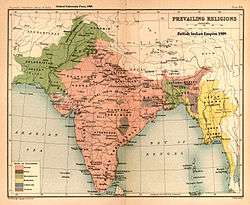
In January 1946, a number of mutinies broke out in the armed services, starting with that of RAF servicemen frustrated with their slow repatriation to Britain.[30] The mutinies came to a head with mutiny of the Royal Indian Navy in Bombay in February 1946, followed by others in Calcutta, Madras, and Karachi. Although the mutinies were rapidly suppressed, they found much public support in India and had the effect of spurring the new Labour government in Britain to action, and leading to the Cabinet Mission to India led by the Secretary of State for India, Lord Pethick Lawrence, and including Sir Stafford Cripps, who had visited four years before.[30]
Also in early 1946, new elections were called in India in which the Congress won electoral victories in eight of the eleven provinces.[31] The negotiations between the Congress and the Muslim League, however, stumbled over the issue of the partition. Jinnah proclaimed August 16, 1946, Direct Action Day, with the stated goal of highlighting, peacefully, the demand for a Muslim homeland in British India. The following day Hindu-Muslim riots broke out in Calcutta and quickly spread throughout India. Although the Government of India and the Congress were both shaken by the course of events, in September, a Congress-led interim government was installed, with Jawaharlal Nehru as united India’s prime minister.
Later that year, the Labour government in Britain, its exchequer exhausted by the recently concluded World War II, decided to end British rule of India, and in early 1947 Britain announced its intention of transferring power no later than June 1948.
As independence approached, the violence between Hindus and Muslims in the provinces of Punjab and Bengal continued unabated. With the British army unprepared for the potential for increased violence, the new viceroy, Louis Mountbatten, advanced the date for the transfer of power, allowing less than six months for a mutually agreed plan for independence. In June 1947, the nationalist leaders, including Nehru and Abul Kalam Azad on behalf of the Congress, Jinnah representing the Muslim League, B. R. Ambedkar representing the Untouchable community, and Master Tara Singh representing the Sikhs, agreed to a partition of the country along religious lines. The predominantly Hindu and Sikh areas were assigned to the new India and predominantly Muslim areas to the new nation of Pakistan; the plan included a partition of the Muslim-majority provinces of Punjab and Bengal.
Many millions of Muslim, Sikh, and Hindu refugees trekked across the newly drawn borders. In Punjab, where the new border lines divided the Sikh regions in half, massive bloodshed followed; in Bengal and Bihar, where Gandhi's presence assuaged communal tempers, the violence was more limited. In all, anywhere between 250,000 and 500,000 people on both sides of the new borders died in the violence.[32] On August 14, 1947, the new Dominion of Pakistan came into being, with Muhammad Ali Jinnah sworn in as its first Governor General in Karachi. The following day, August 15, 1947, India, now a smaller Union of India, became an independent country with official ceremonies taking place in New Delhi, and with Jawaharlal Nehru assuming the office of the prime minister, and the viceroy, Louis Mountbatten, staying on as its first Governor General.
See also
Notes
- ↑ (Stein 2001, p. 259), (Oldenburg 2007)
- ↑ (Oldenburg 2007), (Stein 2001, p. 258)
- 1 2 (Oldenburg 2007)
- ↑ (Stein 2001, p. 258)
- ↑ (Stein 2001, p. 159)
- 1 2 3 (Stein 2001, p. 260)
- ↑ (Bose & Jalal 2003, p. 117)
- 1 2 3 4 Brown 1994, pp. 197–198
- ↑ Olympic Games Antwerp 1920: Official Report, Nombre de bations representees, p. 168. Quote: "31 Nations avaient accepté l'invitation du Comité Olympique Belge: ... la Grèce - la Hollande Les Indes Anglaises - l'Italie - le Japon ..."
- 1 2 3 4 5 6 7 8 9 Brown 1994, pp. 203–204
- 1 2 3 Metcalf & Metcalf 2006, p. 166
- 1 2 3 4 Brown 1994, pp. 201–203
- ↑ Lovett 1920, pp. 94, 187–191
- ↑ Sarkar 1921, p. 137
- ↑ Tinker 1968, p. 92
- 1 2 3 Spear 1990, p. 190
- 1 2 3 Brown 1994, pp. 195–196
- 1 2 3 Stein 2001, p. 304
- ↑ Ludden 2002, p. 208
- 1 2 3 4 5 6 7 8 9 Brown 1994, pp. 205–207
- ↑ (Low 1993, pp. 40, 156)
- 1 2 (Low 1993, p. 154)
- 1 2 (Metcalf & Metcalf 2006, pp. 206–207)
- ↑ Bandyopadhyay 2004, pp. 418–420
- ↑ Nehru 1942, p. 424
- ↑ (Low 1993, pp. 31–31)
- ↑ Lebra 1977, p. 23
- ↑ Lebra 1977, p. 31, (Low 1993, pp. 31–31)
- ↑ Chaudhuri 1953, p. 349, Sarkar 1983, p. 411,Hyam 2007, p. 115
- 1 2 (Judd 2004, pp. 172–173)
- ↑ (Judd 2004, p. 172)
- ↑ (Khosla 2001, p. 299)
References
Contemporary General Histories
- Bandyopadhyay, Sekhar (2004), From Plassey to Partition: A History of Modern India, New Delhi and London: Orient Longmans. Pp. xx, 548., ISBN 81-250-2596-0.
- Bose, Sugata; Jalal, Ayesha (2003), Modern South Asia: History, Culture, Political Economy, London and New York: Routledge, 2nd edition. Pp. xiii, 304, ISBN 0-415-30787-2.
- Brown, Judith M. (1994), Modern India: The Origins of an Asian Democracy, Oxford and New York: Oxford University Press. Pp. xiii, 474, ISBN 0-19-873113-2.
- Copland, Ian (2001), India 1885-1947: The Unmaking of an Empire (Seminar Studies in History Series), Harlow and London: Pearson Longmans. Pp. 160, ISBN 0-582-38173-8.
- Judd, Dennis (2004), The Lion and the Tiger: The Rise and Fall of the British Raj, 1600-1947, Oxford and New York: Oxford University Press. Pp. xiii, 280, ISBN 0-19-280358-1.
- Kulke, Hermann; Rothermund, Dietmar (2004), A History of India, 4th edition. Routledge, Pp. xii, 448, ISBN 0-415-32920-5.
- Ludden, David (2002), India And South Asia: A Short History, Oxford: Oneworld Publications. Pp. xii, 306, ISBN 1-85168-237-6
- Markovits, Claude (ed) (2005), A History of Modern India 1480-1950 (Anthem South Asian Studies), Anthem Press. Pp. 607, ISBN 1-84331-152-6.
- Metcalf, Barbara; Metcalf, Thomas R. (2006), A Concise History of Modern India (Cambridge Concise Histories), Cambridge and New York: Cambridge University Press. Pp. xxxiii, 372, ISBN 0-521-68225-8.
- Peers, Douglas M. (2006), India under Colonial Rule 1700-1885, Harlow and London: Pearson Longmans. Pp. xvi, 163, ISBN 0-582-31738-X.
- Robb, Peter (2004), A History of India (Palgrave Essential Histories), Houndmills, Hampshire: Palgrave Macmillan. Pp. xiv, 344, ISBN 0-333-69129-6.
- Sarkar, Sumit (1983), Modern India: 1885-1947, Delhi: Macmillan India Ltd. Pp. xiv, 486, ISBN 0-333-90425-7.
- Spear, Percival (1990), A History of India, Volume 2, New Delhi and London: Penguin Books. Pp. 298, ISBN 0-14-013836-6.
- Stein, Burton (2001), A History of India, New Delhi and Oxford: Oxford University Press. Pp. xiv, 432, ISBN 0-19-565446-3.
- Wolpert, Stanley (2003), A New History of India, Oxford and New York: Oxford University Press. Pp. 544, ISBN 0-19-516678-7.
Monographs and Collections
- Anderson, Clare (2007), Indian Uprising of 1857–8: Prisons, Prisoners and Rebellion, New York: Anthem Press, Pp. 217, ISBN 978-1-84331-249-9
- Ansari, Sarah (2005), Life after Partition: Migration, Community and Strife in Sindh: 1947–1962, Oxford and London: Oxford University Press, Pp. 256, ISBN 0-19-597834-X
- Bayly, C. A. (1990), Indian Society and the Making of the British Empire (The New Cambridge History of India), Cambridge and London: Cambridge University Press. Pp. 248, ISBN 0-521-38650-0.
- Bayly, C. A. (2000), Empire and Information: Intelligence Gathering and Social Communication in India, 1780-1870 (Cambridge Studies in Indian History and Society), Cambridge and London: Cambridge University Press. Pp. 426, ISBN 0-521-66360-1
- Brown, Judith M. (ed.); Louis (ed.), Wm. Roger (2001), Oxford History of the British Empire: The Twentieth Century, Oxford and New York: Oxford University Press. Pp. 800, ISBN 0-19-924679-3
- Butalia, Urvashi (1998), The Other Side of Silence: Voices from the Partition of India, Durham, NC: Duke University Press, Pp. 308, ISBN 0-8223-2494-6
- Chandavarkar, Rajnarayan (1998), Imperial Power and Popular Politics: Class, Resistance and the State in India, 1850-1950, (Cambridge Studies in Indian History & Society). Cambridge and London: Cambridge University Press. Pp. 400, ISBN 0-521-59692-0.
- Copland, Ian (2002), Princes of India in the Endgame of Empire, 1917-1947, (Cambridge Studies in Indian History & Society). Cambridge and London: Cambridge University Press. Pp. 316, ISBN 0-521-89436-0.
- Fay, Peter W. (1993), The Forgotten Army: India's Armed Struggle for Independence, 1942-1945., Ann Arbor, University of Michigan Press., ISBN 0-472-08342-2.
- Gilmartin, David. 1988. Empire and Islam: Punjab and the Making of Pakistan. Berkeley: University of California Press. 258 pages. ISBN 0-520-06249-3.
- Gould, William (2004), Hindu Nationalism and the Language of Politics in Late Colonial India, (Cambridge Studies in Indian History and Society). Cambridge and London: Cambridge University Press. Pp. 320, ISBN 0-521-83061-3.
- Hyam, Ronald (2007), Britain's Declining Empire: The Road to Decolonisation 1918-1968., Cambridge University Press., ISBN 0-521-86649-9.
- Jalal, Ayesha (1993), The Sole Spokesman: Jinnah, the Muslim League and the Demand for Pakistan, Cambridge, UK: Cambridge University Press, 334 pages, ISBN 0-521-45850-1.
- Khan, Yasmin (September 18, 2007), The Great Partition: The Making of India and Pakistan, New Haven and London: Yale University Press, 250 pages, ISBN 0-300-12078-8
- Khosla, G. D. (2001), "Stern Reckoning", in Page, David; Inder Singh, Anita; Moon, Penderal; Khosla, G. D.; Hasan, Mushirul, The Partition Omnibus: Prelude to Partition/the Origins of the Partition of India 1936-1947/Divide and Quit/Stern Reckoning, Delhi and Oxford: Oxford University Press, ISBN 0-19-565850-7
- Low, D. A. (1993), Eclipse of Empire, Cambridge and London: Cambridge University Press. Pp. xvi, 366, ISBN 0-521-45754-8.
- Low, D. A. (2002), Britain and Indian Nationalism: The Imprint of Amibiguity 1929-1942, Cambridge and London: Cambridge University Press. Pp. 374, ISBN 0-521-89261-9.
- Low, D. A. (ed.) (2004) [1977], Congress & the Raj: Facets of the Indian Struggle 1917-47, New Delhi and Oxford: Oxford University Press. Pp. xviii, 513, ISBN 0-19-568367-6.
- Metcalf, Thomas R. (1991), The Aftermath of Revolt: India, 1857-1870, Riverdale Co. Pub. Pp. 352, ISBN 81-85054-99-1
- Metcalf, Thomas R. (1997), Ideologies of the Raj, Cambridge and London: Cambridge University Press, Pp. 256, ISBN 0-521-58937-1
- Pandey, Gyanendra (2002), Remembering Partition: Violence, Nationalism and History in India, Cambride, UK: Cambridge University Press, p. 232, ISBN 0-521-00250-8
- Porter, Andrew (ed.) (2001), Oxford History of the British Empire: Nineteenth Century, Oxford and New York: Oxford University Press. Pp. 800, ISBN 0-19-924678-5
- Ramusack, Barbara (2004), The Indian Princes and their States (The New Cambridge History of India), Cambridge and London: Cambridge University Press. Pp. 324, ISBN 0-521-03989-4
- Shaikh, Farzana. 1989. Community and Consensus in Islam: Muslim Representation in Colonial India, 1860—1947. Cambridge, UK: Cambridge University Press. 272 pages. ISBN 0-521-36328-4.
- Talbot, Ian and Gurharpal Singh (eds). 1999. Region and Partition: Bengal, Punjab and the Partition of the Subcontinent. Oxford and New York: Oxford University Press. 420 pages. ISBN 0-19-579051-0.
- Talbot, Ian. 2002. Khizr Tiwana: The Punjab Unionist Party and the Partition of India. Oxford and New York: Oxford University Press. 216 pages. ISBN 0-19-579551-2.
- Wainwright, A. Martin (1993), Inheritance of Empire: Britain, India, and the Balance of Power in Asia, 1938-55, Praeger Publishers. Pp. xvi, 256, ISBN 0-275-94733-5.
- Wolpert, Stanley (2006), Shameful Flight: The Last Years of the British Empire in India, Oxford and New York: Oxford University Press. Pp. 272, ISBN 0-19-515198-4.
Articles in journals or collections
- Banthia, Jayant; Dyson, Tim (December 1999), "Smallpox in Nineteenth-Century India", Population and Development Review, Population Council, 25 (4): 649–689, doi:10.2307/172481, JSTOR 172481
- Brown, Judith M. (2001), "India", in Brown, Judith M.; Louis, Wm. Roger, Oxford History of the British Empire: The Twentieth Century, Oxford and New York: Oxford University Press, pp. 421–446, ISBN 0-19-924679-3
- Caldwell, John C. (December 1998), "Malthus and the Less Developed World: The Pivotal Role of India", Population and Development Review, Population Council, 24 (4): 675–696, doi:10.2307/2808021, JSTOR 2808021
- Derbyshire, I. D. (1987), "Economic Change and the Railways in North India, 1860-1914", Population Studies, Cambridge University Press, 21 (3): 521–545, doi:10.2307/312641, JSTOR 312641
- Drayton, Richard (2001), "Science, Medicine, and the British Empire", in Winks, Robin, Oxford History of the British Empire: Historiography, Oxford and New York: Oxford University Press, pp. 264–276, ISBN 0-19-924680-7
- Dyson, Tim (March 1991), "On the Demography of South Asian Famines: Part I", Population Studies, Taylor & Francis, 45 (1): 5–25, doi:10.1080/0032472031000145056, JSTOR 2174991
- Dyson, Tim (July 1991), "On the Demography of South Asian Famines: Part II", Population Studies, Taylor & Francis, 45 (2): 279–297, doi:10.1080/0032472031000145446, JSTOR 2174784
- Frykenberg, Robert E. (2001), "India to 1858", in Winks, Robin, Oxford History of the British Empire: Historiography, Oxford and New York: Oxford University Press, pp. 194–213, ISBN 0-19-924680-7
- Gilmartin, David (November 1994), "Scientific Empire and Imperial Science: Colonialism and Irrigation Technology in the Indus Basin", The Journal of Asian Studies, Association for Asian Studies, 53 (4): 1127–1149, doi:10.2307/2059236, JSTOR 2059236
- Goswami, Manu (October 1998), "From Swadeshi to Swaraj: Nation, Economy, Territory in Colonial South Asia, 1870 to 1907", Comparative Studies in Society and History, Cambridge University Press, 40 (4): 609–636, doi:10.1017/s0010417598001674, JSTOR 179304
- Harnetty, Peter (July 1991), "'Deindustrialization' Revisited: The Handloom Weavers of the Central Provinces of India, c. 1800-1947", Modern Asian Studies, Cambridge University Press, 25 (3): 455–510, doi:10.1017/S0026749X00013901, JSTOR 312614
- Heuman, Gad (2001), "Slavery, the Slave Trade, and Abolition", in Winks, Robin, Oxford History of the British Empire: Historiography, Oxford and New York: Oxford University Press, pp. 315–326, ISBN 0-19-924680-7
- Klein, Ira (1988), "Plague, Policy and Popular Unrest in British India", Modern Asian Studies, Cambridge University Press, 22 (4): 723–755, doi:10.2307/312523, JSTOR 312523
- Klein, Ira (July 2000), "Materialism, Mutiny and Modernization in British India", Modern Asian Studies, Cambridge University Press, 34 (3): 545–580, JSTOR 313141
- Kubicek, Robert (2001), "British Expansion, Empire, and Technological Change", in Porter, Andrew, Oxford History of the British Empire: The Nineteenth Century, Oxford and New York: Oxford University Press, pp. 247–269, ISBN 0-19-924678-5
- Moore, Robin J. (2001a), "Imperial India, 1858-1914", in Porter, Andrew, Oxford History of the British Empire: The Nineteenth Century, Oxford and New York: Oxford University Press, pp. 422–446, ISBN 0-19-924678-5
- Moore, Robin J. (2001b), "India in the 1940s", in Winks, Robin, Oxford History of the British Empire: Historiography, Oxford and New York: Oxford University Press, pp. 231–242, ISBN 0-19-924680-7
- Raj, Kapil (2000), "Colonial Encounters and the Forging of New Knowledge and National Identities: Great Britain and India, 1760-1850", Osiris, 2nd Series, The University of Chicago Press, 15 (Nature and Empire: Science and the Colonial Enterprise): 119–134, doi:10.1086/649322, JSTOR 301944
- Ray, Rajat Kanta (July 1995), "Asian Capital in the Age of European Domination: The Rise of the Bazaar, 1800-1914", Modern Asian Studies, Cambridge University Press, 29 (3): 449–554, doi:10.1017/S0026749X00013986, JSTOR 312868
- Raychaudhuri, Tapan (2001), "India, 1858 to the 1930s", in Winks, Robin, Oxford History of the British Empire: Historiography, Oxford and New York: Oxford University Press, pp. 214–230, ISBN 0-19-924680-7
- Robb, Peter (May 1997), "The Colonial State and Constructions of Indian Identity: An Example on the Northeast Frontier in the 1880s", Modern Asian Studies, Cambridge University Press, 31 (2): 245–283, doi:10.1017/s0026749x0001430x, JSTOR 313030
- Roy, Tirthankar (Summer 2002), "Economic History and Modern India: Redefining the Link", The Journal of Economic Perspectives, American Economic Association, 16 (3): 109–130, doi:10.1257/089533002760278749, JSTOR 3216953
- Simmons, Colin (1985), "'De-Industrialization', Industrialization and the Indian Economy, c. 1850-1947", Modern Asian Studies, Cambridge University Press, 19 (3): 593–622, doi:10.1017/s0026749x00007745, JSTOR 312453
- Talbot, Ian (2001), "Pakistan's Emergence", in Winks, Robin, Oxford History of the British Empire: Historiography, Oxford and New York: Oxford University Press, pp. 253–263, ISBN 0-19-924680-7
- Tinker, Hugh (1968), "India in the First World War and after.", Journal of Contemporary History, Sage Publications, 3 (4): 89–107, ISSN 0022-0094.
- Tomlinson, B. R. (2001), "Economics and Empire: The Periphery and the Imperial Economy", in Porter, Andrew, Oxford History of the British Empire: The Nineteenth Century, Oxford and New York: Oxford University Press, pp. 53–74, ISBN 0-19-924678-5
- Washbrook, D. A. (2001), "India, 1818-1860: The Two Faces of Colonialism", in Porter, Andrew, Oxford History of the British Empire: The Nineteenth Century, Oxford and New York: Oxford University Press, pp. 395–421, ISBN 0-19-924678-5
- Watts, Sheldon (November 1999), "British Development Policies and Malaria in India 1897-c. 1929", Past & Present, Oxford University Press, 165 (165): 141–181, doi:10.1093/past/165.1.141, JSTOR 651287
- Wylie, Diana (2001), "Disease, Diet, and Gender: Late Twentieth Century Perspectives on Empire", in Winks, Robin, Oxford History of the British Empire: Historiography, Oxford and New York: Oxford University Press, pp. 277–289, ISBN 0-19-924680-7
Classic Histories and Gazetteers
- Imperial Gazetteer of India vol. IV (1907), The Indian Empire, Administrative, Published under the authority of His Majesty's Secretary of State for India in Council, Oxford at the Clarendon Press. Pp. xxx, 1 map, 552.
- Lovett, Sir Verney (1920), A History of the Indian Nationalist Movement, New York, Frederick A. Stokes Company, ISBN 81-7536-249-9
- Majumdar, R. C.; Raychaudhuri, H. C.; Datta, Kalikinkar (1950), An Advanced History of India, London: Macmillan and Company Limited. 2nd edition. Pp. xiii, 1122, 7 maps, 5 coloured maps..
- Smith, Vincent A. (1921), India in the British Period: Being Part III of the Oxford History of India, Oxford: At the Clarendon Press. 2nd edition. Pp. xxiv, 316 (469-784).
Tertiary Sources
- Oldenburg, Philip (2007), "India: Movement for Freedom", Encarta Encyclopedia, archived from the original on 2009-10-31.
- Wolpert, Stanley (2007), "India: British Imperial Power 1858-1947 (Indian nationalism and the British response, 1885-1920; Prelude to Independence, 1920-1947)", Encyclopædia Britannica.
